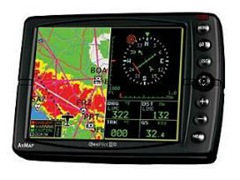A pilot named Heather H recently asked a great question on Ask a Flight Instructor about whether she should use a handheld GPS or her iPhone as a navigation backup. Specifically, Heather will be transitioning from a G1000 aircraft into an older plane with only a single VOR for navigation and she wrote that:
Aside from the radio and looking out the window, I’d like to have a more solid backup plan for assuring I’m on the right path.
I have an iPhone but I honestly don’t know much about iPhone apps and aviation, are there any simple apps that don’t cost a fortune in subscription fees to just verify my position or should I buy a used, handheld GPS? (It wouldn’t need to even display a sectional, weather, etc…)
Heather added that the handheld GPS or iPhone would be for backup purposes and piece of mind. In addition, she would be flying VFR with paper charts and is just looking for a simple iPhone solution for backup purposes.
Bob Watson responded by writing that he has flown 20 years without a GPS and has always managed to find the airport. Bob also thought the iPhone should stay turned off in Heather’s pocket because he knows what its like to transition from a well-equipped aircraft to a more basic one. However, he added that once she gets used to  the more basic aircraft, it will be “a lot more fun.” Otherwise, Bob wrote that a handheld GPS that’s an aviation model would be easier and safer to use than an iPhone or a non-aviation GPS model.
the more basic aircraft, it will be “a lot more fun.” Otherwise, Bob wrote that a handheld GPS that’s an aviation model would be easier and safer to use than an iPhone or a non-aviation GPS model.
John D. Collins then wrote that he uses the ForeFlight APP ($75 per year) in lieu of carrying paper charts but he will still carry some – including his primary and alternate approach charts. John had also recently flew from Charlotte to Oshkosh and was forced to divert to Lexington Kentucky for fuel on the way back because of bad weather. Since he did not have a copy of the approach charts on board, he used the approach charts from ForeFlight.
Finally, Jim Post wrote that he has flown for 50 years without a GPS and he has always managed to get where he was going. Jim has even used road atlases and a pair of binoculars to read water towers but he has started to learn how to use a GPS and he likes what he sees. He also added that having a redundant navigation aid does not hurt from a safety standpoint.
I just turned 60, so I guess I’m an old geezer now. I learned to fly in 1970 in a J-3. I’m also a retired USAF navigator, and most of my flying was in the pre-gps days.
On the other hand, since I retired from the Air Force in 1994 I’ve worked exclusively in small internet start up companies, so I’m not afraid of new technology.
I absolutely cringe when some old geezer says something like ‘I’ve flown for 99 years and I’ve never needed any of these new-fangled gadgets!’.
This sort of statement displays a hazardous attitude in my opinion. Just because some old geezer is too fixed in his antique ways to use every available tool to increase safety and situation awareness is no reason to give him any credence.
By all means Heather should use her iPhone as a backup to the single VOR in her new airplane! I would be absolute malpractice to not encourage her to do so.
Does that mean she shouldn’t learn how to navigate with paper charts? NO.
Does than mean that she would be a better pilot if she she had first trained in a J-3 rather than a G-1000 Cessna? NO.
It’s sad that stick and rudder flying seems to be taking a back seat to button pushing in a lot of flying schools these days. Not ever pilot will wind up in an Airbus, and even Airbus pilots might have to still know the basics someday.
It’s sad that few students don’t get at least some expose to a airplane as part of their training.
Having said all that, it is still very smart for any pilot to use a modern smart phone or tablet as an add to situation awareness and a backup nav system for when the panel screens go dark.